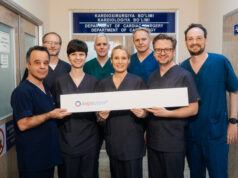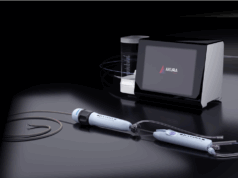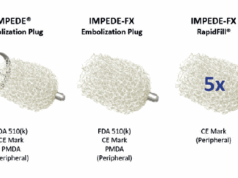Conditional FDA approval in January of the Gore TAG thoracic endoprothesis has been interpreted as a positive step regarding expansion in this segment. Takao Ohki, head of the division of Vascular and Endovascular Surgery, Albert Einstein College of Medicine, in the Montefiore Medical Centre in New York, was optimistic about prospects for the market. He forecast that the number of procedures would more than double in 2005 from 10,200 to 22,000. He believed that this could represent a $220 to $250 million opportunity for interested players in the longer term. When Vascular News talked to him he stated that he felt that cost of the devices would not be a barrier to adoption at all. The cost of the thoracic stent graft was not going to exceed that of its abdominal aortic aneurysm equivalent, Ohki told Vascular News , stating that “many believe the benefit of stenting is bigger in thoracic than it is in abdominal aortic aneurysm” so adoption was more, rather than less, likely.However, certainly compared to the European market, device approval mechanisms run slowly in the US. Gary Lemmon, who works at the Good Samaritan Hospital in Dayton Ohio, stated “Thoracic Aortic Aneurysm (TAA) devices are only available at FDA IDE sites across the country.” He also added that at the moment, pending introduction of dedicated thoracic stent grafts, “aortic extender cuffs are being used for limited coverage of thoracic lesions such as penetrating ulcers or traumatic aortic tears”. So at this stage the TAA market is yet to be affected by the TAG device, but this is surely only months away. When asked about the approval process, Ohki envisaged the FDA making a final recommendation over the next month or so after the final consultations took place in mid-March. He expected that the 10 participating hospitals of the clinical trial would expect product in April to May and after that, the second tier of highly experienced endovascular specialists will get devices around June/July.
In the past there was a role for home made thoracic devices in the US. Now these devices only play a peripheral role in the market. Michael Dake, Associate Professor of Radoiology, Stanford University, said “homemade devices played a peripheral role in the market” and believed “they only represented 1% of the market”. This he attributed to the “multiple companies trailing stent grafts in the US such as Cook and Medtronic”. He also expected other companies such as Boston Scientific to enter this market. Dake said “without a doubt TAA Stent grafts will play a role”, which he explained by saying “the main reason that thoracic stent grafts will take off is that the benefits of them were far more apparent to the individual physician/surgeon relative to open surgery.” He then quoted some of the latest Gore Tag trial data, which showed aneurysm related mortality at two years at only 2% as opposed to 6.4% in the open surgery control group. Frank Criado, who is chief of the division for Vascular Surgery at the Union Memorial Hospital in Baltimore was even more emphatic. He felt thoracic stent grafts had the potential to become as big as it is in the abdominal aortic aneurysm market. He said the market was poised to “explode” to be much larger in the near future. Also that “the thoracic aorta was the best application for this technology”.
Dake also pointed out abdominal aortic aneurysms are the only application for stent graft technology in the abdominal aorta. He pointed out that in the abdominal aorta, stent grafts were the only application for stent graft technology. However, in the thoracic aorta there is a multiplicity of applications not just aneurysms but dissections, trauma and ulcers.
Which are the major centers in the stents at the forefront of this technology? In no particular order of importance we feel that Stanford, Arizona Heart in Phoenix, Mount Sinai in NY, Union Memorial in Baltimore, UPenn in Philadelphia, The Miami Cardiac and Vascular Institute and the Massachusetts General hospital in Boston are major centers for TAA stent graft trials. Indeed most of theses have experience of over 150 implants. However a lot of smaller institutions are involved, so this list is far from exhaustive.
So what is going to happen to this market? Clearly the FDA approval of the Gore Tag is going to have a major effect on the market. Takao Ohki believes that a doubling of the number of TAA procedures in the US in 2005 compared to 2004 is possible, which is especially interesting against the background of a static market over the last three years.
Worldwide the position is less clear as there are multiple factors to consider such as when Japanese reimbursement will start. Ohki explained that unlike in the US, there is a significant market for home-made stent grafts in Japan. He informed us that there is a CPT code specifically for thoracic stent grafting, which was implemented in 2002. So for two and a half years there has been a surgical code for thoracic stenting but no approved devices. He felt that the present situation presented something of a paradox and that “nobody wants to make the device and carry the legal risk”.
To conclude, in the US FDA approval of devices such as the Medtronic Talent and the Cook Zenith TX2 are important factors but key opinion leaders are very optimistic on the subject, as also are many other vascular surgeons. We’ll leave the last word to Frank Criado.”Many of us believe that the potential thoracic market is as big as the abdominal aortic aneurysm market!”













